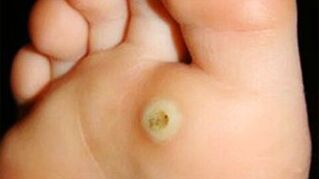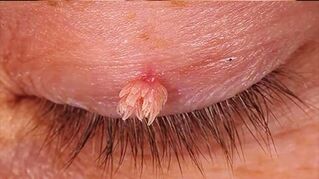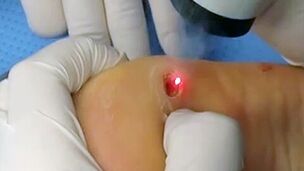
Warts are small aesthetic neoplasms that appear on the skin when infected with human papillomavirus. It causes the proliferation of virus cells that enter the upper layers of the epidermis, resulting in warts of various shapes, sizes and colors.
Human papillomavirus infects about 80% of the world's population, and not every patient knows his or her diagnosis because HPV is often asymptomatic.
Types of warts
There are different types of warts in the body depending on their location, color, size, shape and type of pathogen.
Common or vulgar warts
The most common images do not depend on the age and sex of the patient. They are located on the hands, between the fingers, behind the palms (less on the palms themselves). Vulgar warts are irregular or round in shape and are generally not very noticeable on the skin due to their fleshy pink color. The size varies from 1 to 3 mm; groups of neoplasms may appear in the affected area with long-term infection and lack of treatment.
Straight warts
Neoplasms of this type are more common in children and adolescents, so the second name is juvenile warts. These are oval or round flesh or light brown knots with a soft surface, slightly raised above the skin. It is mainly localized on the face, neck, arms and upper skin.

plant warts
This type of wart appears only on the skin of the feet and is therefore called. It is a rough growth with a keratinized skin layer or a group of such growths. The skin around the plantar warts loses its natural color and turns gray-yellow. The surface of the wart hardens and begins to press on the surrounding healthy tissue, which is a serious concern.
Dependent warts
The peculiarity of this species is that it has a narrow articulation with the surface of the skin called "legs". Hanging warts can be elongated, round or irregular, pink or red. Such warts are localized in women under the neck, face, underarms and under the breasts. The appearance of numerous hanging warts often indicates a sharp decrease in the body's immune status.
Old warts
This type of wart is more likely to affect the skin of older people. These are also called seborrheic warts or keratomas. It develops due to age-related changes and deterioration of metabolism in the cells of the epidermis, and often occupies the upper part of the hair follicles. Keratomas are round in shape, have well-defined borders, and are localized on the scalp or face. The size varies from a few millimeters to 4-5 cm.

Genital warts
Genital warts or condylomata are the most unpleasant and painful type of neoplasm. They are caused by human papillomavirus types 6 and 11. Genital warts affect the skin adjacent to the mucous membrane: on the lips and eyelids; in the genital area, urethra, anus.
Genital warts often have a nodular growth structure comparable to cauliflower or rooster. Condylomata attach to the skin surface through a thin "foot". Due to its localization in areas of the body that are sensitive to mechanical irritation, genital warts and high levels of damage to adjacent tissues, the formation of exudative or purulent discharge, an infectious and inflammatory process develops.
Causes of warts
Increased activity of human papillomavirus in the body causes the appearance of warts. Infection occurs in contact and in everyday life: touching, shaking hands, sharing common objects and public places without following the rules of personal hygiene. Genital warts are sexually transmitted.
The virus enters its active form in the following factors:
- severe or chronic stress;
- transmitted infectious diseases;
- decreased immunity;
- hormonal disorders, improper metabolism;
- excessive sweating;
- skin trauma and microtrauma;
- Wear clothes and shoes made of unnatural materials.
If the disease is asymptomatic, it can only be diagnosed by a laboratory.
Warts in adults
The appearance of papillomas or warts is possible at any age. In this situation, sex does not play a special role - both men and women are susceptible to HPV. At the same time, women are at a higher risk of developing warts because their immunity is often weakened due to hormonal levels, pregnancy and child nutrition. Due to the anatomical features, women are more sensitive to the appearance of genital warts, which increase the risk of developing genital warts, especially cervical cancer.
In men, warts appear only in the case of a sharp decrease in immunity, and this does not happen so often with members of the opposite sex. At the same time, men are carriers of HPV types 16 and 18, which rarely lead to the development of oncological diseases.
Warts in children
Warts are a common occurrence in children and adolescents because they are easily infected with papillomaviruses because their immunity is not fully formed. Children in kindergartens and schools, as a rule, are in a stressful situation, which has a negative impact on the body's defenses. In addition to the method of infection by home infection, congenital uterine infection is also possible.
Children often develop vulgar, juvenile or plantar warts, and adolescent warts disappear by themselves at the age of 14-18.

treatment of warts
When treating warts, it should be understood that it is not possible to completely eliminate the pathogen - human papillomavirus. Once inside the body, it stays inside forever, but healthy immunity can keep it under control and minimize the manifestations of vital activity.
The very appearance of warts indicates a decrease in the body's immune system, so measures to strengthen the immune system should be included in HPV therapy. With the body's reduced defensive response, even with successful removal of warts, the chances of recurrence are high. However, in people with strong immunity, warts can go away on their own.
Therapy should be selected by a qualified physician after a thorough examination. Self-medication is unacceptable because a layman will not be able to distinguish a wart from a malignant neoplasm. An expert also decides on the removal of awarts- a damaged neoplasm can turn from benign to malignant.
Here are some ways to get rid of warts.
- Cryodestruction (freezing with liquid nitrogen). This method is especially effective for common warts. The neoplasm is exposed to liquid nitrogen for 10-30 seconds. This method is useful for low trauma; It takes 1 to 5 sessions to completely remove the wart.
- Laser coagulation (laser removal). The neoplasm is partially removed under local anesthesia. A wart remains in the place of the wart, which disappears after about a month.
- Electrocoagulation (current removal). The wart is removed with a thin metal loop using a high-frequency current. This method is characterized by the absence of bleeding and additional tissue disinfection. Neoplasmic tissues remain intact, so they can be sent for histological examination. Traces of manipulation disappear within a week.
- Surgical excision. This method is used only in extreme cases, when the neoplasms are very large or in the case of a single conglomeration. Under local anesthesia, the wart is removed with a scalpel, as in conventional surgery. The extracted material is sent for histological examination. The presence of scars at the excision site depends on the skill of the surgeon applying the suture.
- A chemical attack method that uses various acids or alkalis. This method is the most painful, traumatic and dangerous, because the risk of secondary tissue infection at the site of exposure is very high. When deciding to use it, it is worth remembering that you can move only on the wart itself, without affecting the nearby skin.
Medications for the treatment of warts
Topical medications are used to treat warts, but their effectiveness depends on the age of the neoplasm - the more frequent the wart, the more likely it is to be removed and the patient's immunity.
Before using topical medications, you should consult a dermatologist and perform tests to determine the nature of the neoplasms, as exposure to medications can cause warts to turn into malignant substances.
Non-traditional methods to fight warts
Traditional medicine recipes are used:
- garlic;
- yay;
- celandine;
- ripple;
- wormwood;
- flaxseed oil.
Traditional medicine is a good adjunct to general treatment after consulting your doctor.
Wart Prevention
The best way to prevent the formation of warts is to follow the rules of personal hygiene in a simple way: timely hand washing, use of personal manicure accessories, towels, clothes, shoes. You should not go barefoot in the pool, shared showers, baths and saunas. It is also worth taking antiseptics for the treatment of baths while staying in hotels. In parallel, it is necessary to strengthen the immune system and pay attention to the general state of health.























